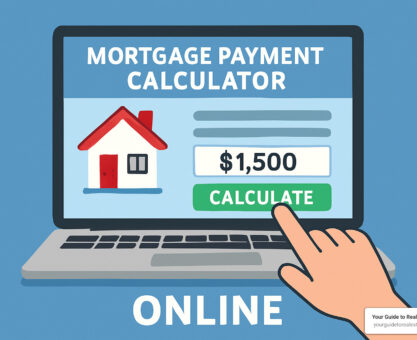Your Roadmap to Homeownership Success
Easy steps to buying your first home don’t have to be complicated. Here’s a quick overview of the process:
- Check your financial health – Review credit score, debt-to-income ratio, and savings
- Get pre-approved for a mortgage – Shop lenders and understand your budget
- Find a trusted real estate agent – Seek referrals and interview candidates
- Search for your home – Create a needs vs. wants list and tour properties
- Make an offer and negotiate – Submit competitive terms with contingencies
- Close on your new home – Complete inspection, appraisal, and final paperwork
Buying a home is one of life’s most exciting milestones, but it can feel overwhelming without a clear path forward. The typical homebuyer looks at about ten homes over several weeks before finding “the one,” and the entire process usually takes 30-45 days from application to closing.
Don’t worry about needing a massive down payment. While 20% down is ideal to avoid private mortgage insurance (PMI), the average down payment today is closer to 6%, and some loan programs require as little as 0-3.5% down.
Your housing costs should ideally stay below 25% of your monthly take-home pay, including taxes, insurance, and any HOA fees. This gives you breathing room for other life goals and unexpected expenses.
Buying a home isn’t about perfect timing – it’s about finding the right property when you’re financially ready. As one homeowner put it: “Don’t lose heart, and don’t feel pressured into making an offer that’s outside your budget.”

Step 1 – Check Your Financial Health
Ready to start house hunting? Not so fast! Before you fall in love with that charming colonial or modern condo, let’s make sure your finances are in great shape for this exciting journey.
Think of checking your financial health as laying the foundation for your future home. This crucial first step helps you understand what you can truly afford and sets you up for homebuying success.
Your credit score is like your financial report card for lenders. Most conventional loans look for a minimum score of 620, while FHA loans might work with scores as low as 580. Remember—the higher your score, the better your interest rate, which could save you thousands over your mortgage lifetime.
Next, take a look at your debt-to-income (DTI) ratio. This simple calculation (monthly debt payments divided by gross monthly income) tells lenders how much of your income is already spoken for. According to the Consumer Financial Protection Bureau, a DTI of 43% or lower is typically preferred for mortgage approval.
“Having a DTI ratio of 43% or less is important because studies have shown that borrowers with a higher debt-to-income ratio are more likely to run into trouble making monthly payments,” explains housing counselor Maria Rodriguez.
Don’t overlook your emergency fund! Financial experts suggest having 3-6 months of living expenses saved before taking the homeownership plunge. When the water heater suddenly quits or the roof springs a leak, you’ll be thankful for this safety net.
The rent-vs-buy decision isn’t just about comparing monthly payments. Consider your plans—will you stay in the area at least 3-5 years? What’s happening in the local housing market? How important is maintenance-free living to you? Ideally, your total housing costs should stay below 25% of your monthly take-home pay to keep your budget healthy.
Easy steps to buying your first home: Financial Checklist
Before mortgage shopping, strengthen your financial position with these simple steps:
- Pull your credit report from all three bureaus through AnnualCreditReport.com
- Dispute any errors you find—they’re surprisingly common!
- Work on paying down existing debt to improve your DTI ratio
- Avoid opening new credit accounts or making large purchases during the homebuying process
- Save aggressively for your down payment and closing costs
- Maintain steady employment—job changes can complicate mortgage approval
“I had no idea a small error on my credit report was dragging down my score by nearly 40 points,” shares first-time homebuyer James Wilson. “Taking the time to dispute it and get it removed helped me qualify for a much better interest rate.”
Taking these easy steps to buying your first home might delay your house hunt by a few months, but the financial preparation will make the entire process smoother and potentially save you thousands in the long run. Trust me—your future self will thank you for doing this groundwork!
Step 2 – Secure Your Financing
Getting pre-approved for a mortgage is truly one of the most crucial easy steps to buying your first home. There’s a big difference between pre-qualification (which is just a rough estimate based on what you tell a lender) and pre-approval, which involves a thorough review of your financial documents and a hard credit check.
Think of your pre-approval letter as your golden ticket in the homebuying process. It shows sellers you’re serious and gives you a clear budget to work with. This isn’t just paperwork—it’s your passport to being taken seriously when you find your dream home.
“When I made an offer on my first home, the seller chose my bid over a slightly higher one because I had a pre-approval letter in hand,” recalls homeowner Sarah Johnson. “It gave them confidence that the deal wouldn’t fall through due to financing issues.”
I always recommend shopping around with at least three different lenders. Even a tiny difference in interest rate—we’re talking fractions of a percentage point—can save you thousands over your mortgage lifetime. Don’t be shy about comparing rates, fees, and loan terms!
For your down payment, aim to save between 3-20% of your target home price, depending on the loan type you choose. While putting 20% down helps you avoid PMI (Private Mortgage Insurance), it’s not always necessary or realistic, especially if you’re buying your first home.
Remember to factor in closing costs, which typically run between 3-6% of your loan amount. These include various lender fees, appraisal costs, title insurance, and prepaid expenses like property taxes and homeowners insurance. These costs catch many first-time buyers by surprise!
If you’re fortunate enough to have family members helping with your down payment, you’ll need proper documentation. Most lenders require a gift letter stating the money doesn’t need to be repaid. Be prepared to show the source of these funds as well—lenders want to make sure you’re not taking on additional debt.

Compare Popular Loan Options
Different mortgage types serve different needs. Here’s a quick comparison:
| Loan Type | Minimum Down Payment | Minimum Credit Score | Best For |
|---|---|---|---|
| Conventional | 3% | 620 | Buyers with good credit and stable income |
| FHA | 3.5% | 580 (or 500 with 10% down) | First-time buyers with lower credit scores |
| VA | 0% | No set minimum (typically 620) | Eligible veterans and service members |
| USDA | 0% | 640 (typically) | Low to moderate-income buyers in rural areas |
If you put less than 20% down on a conventional loan, you’ll typically need to pay for Private Mortgage Insurance (PMI). The good news is you can drop this once you reach 20% equity in your home. FHA loans work a bit differently—they include Mortgage Insurance Premiums (MIP) for the life of the loan if you put less than 10% down.
“We went with an FHA loan because our credit wasn’t perfect, and we only had about 5% saved for a down payment,” explains first-time homeowner Miguel Santos. “The slightly higher monthly payment due to mortgage insurance was worth it to get into our home sooner rather than waiting years to save 20%.”
Don’t worry if all these options seem overwhelming at first—that’s completely normal! For a deeper dive into mortgage options and how they work, check out our comprehensive guide to Understanding Mortgages. It breaks everything down into simple, digestible information that makes the whole process much less intimidating.
Step 3 – Easy Steps to Buying Your First Home — House Hunting Made Simple
Now comes the exciting part! With pre-approval letter in hand and budget clearly defined, it’s time to find the home of your dreams. Before you start scrolling through listings or visiting open houses, take a moment to distinguish between what you truly need versus what would be nice to have.
Your needs are the non-negotiable features – perhaps three bedrooms for your growing family, a maximum 30-minute commute to work, or being within a specific school district. Wants, on the other hand, might include that gorgeous updated kitchen, a spacious backyard for summer barbecues, or the charming architectural details that make your heart skip a beat.
“We fell in love with a house only to find the neighborhood had terrible rush hour traffic that would have doubled my commute time,” shares homebuyer Alicia Chen. “Taking the time to visit during morning rush hour saved us from making a huge mistake.”
Neighborhood research is just as important as the house itself. I always recommend visiting potential areas at different times – early morning, rush hour, weekend evenings – to get a genuine feel for the community rhythm. Check out the school ratings even if you don’t have children, as they significantly impact resale value. Map out the amenities that matter in your daily life: grocery stores, parks, healthcare facilities, and your favorite coffee shop!
When attending showings or open houses, bring a checklist to help evaluate each property consistently. Your future self will thank you when you’re trying to remember which house had the updated electrical system or the north-facing windows.

Easy steps to buying your first home: Search Strategy
Working with a knowledgeable real estate agent can transform your home search from overwhelming to enjoyable. More than half of homebuyers find their agent through personal recommendations, so don’t hesitate to ask friends and family about their experiences.
A good agent becomes your property matchmaker, neighborhood guide, and negotiation expert all in one. They’ll help refine your search criteria, alert you to fresh listings that match your needs, and provide invaluable local insights that online listings simply can’t offer.
Understanding current market conditions in your target areas is crucial. In a buyer’s market with plenty of inventory, you might have more negotiating power. In a seller’s market where homes fly off the market in days (sometimes hours!), you’ll need to be prepared to act quickly and potentially offer above asking price.
Don’t feel pressured to rush this important decision. The average homebuyer tours about ten properties before finding “the one.” Trust your instincts and give yourself permission to take the time you need. Virtual tours and 3D walkthroughs have become wonderful tools for pre-screening properties, but nothing replaces the feeling of walking through a space and imagining your life there.
“When we walked into our current home, I could immediately picture where our Christmas tree would go and how our furniture would fit,” says first-time homeowner Michael Torres. “That gut feeling told me this was the place, even though it wasn’t the fanciest house we saw.”
Finding your home is a marathon, not a sprint. The easy steps to buying your first home include being patient with the process and keeping your priorities straight.
For more detailed guidance that will make your home search smoother and more successful, check out our comprehensive guide with First-Time Homebuyer Tips.
Step 4 – Make an Offer & Do Your Due Diligence
You’ve found “the one”—now it’s time to make it yours! Making an offer involves much more than just naming your price. Think of it as a complete package that shows sellers you’re serious and prepared.
Your offer will include several key elements: the purchase price, earnest money deposit (typically 1-2% of the purchase price), your preferred closing date, protective contingencies, any items you’d like included (like those stainless appliances or custom window treatments), your pre-approval letter, and sometimes a personal letter to the seller.
“When we found our dream home, our agent helped us craft an offer that stood out among multiple bids—without breaking our budget,” shares first-time homebuyer Jamie Wilson. “The personal letter actually made a difference because we connected with the sellers over our shared love of gardening!”
Your real estate agent will be invaluable here, helping you determine a competitive offer price based on comparable sales, the home’s condition, and current market dynamics. In hot markets, you might need to offer above asking price, while in slower markets, you might have room to negotiate down.
The earnest money deposit shows you’re committed to the purchase. This good-faith deposit is held in escrow and typically applied to your down payment at closing. Just be aware—if you back out for reasons not covered by your contingencies, this money could be at risk.
Speaking of contingencies, these are your safety nets! Common ones include:
- Financing contingency: Your escape hatch if your mortgage falls through
- Inspection contingency: Gives you negotiating power based on inspection findings
- Appraisal contingency: Protects you if the home appraises for less than your offer
- Title contingency: Ensures the property has a clear title with no ownership disputes
Once your offer is accepted (congratulations!), the due diligence period begins. The home inspection is perhaps the most critical step in these easy steps to buying your first home. For $300-$500, a professional inspector will thoroughly examine the property’s structure, major systems, and safety concerns.

“Our inspector found that the home needed a new roof, which would have cost us $15,000 right after purchase,” recalls homebuyer David Thompson. “We were able to negotiate a $10,000 price reduction to help cover the cost—money we would have lost without the inspection.”
The appraisal, required by your lender, ensures the home is worth at least what you’re paying. According to research from Freddie Mac, appraisals help ensure buyers don’t overpay and lenders don’t over-lend, protecting both parties in the transaction. If the home appraises below your offer price, you’ll need to make up the difference in cash, renegotiate, or potentially walk away if protected by your contingency.
Post-Inspection Negotiation Tactics
If your inspection reveals issues (and most do!), don’t panic. You have several options to consider:
You can request repairs and ask the seller to fix specific problems before closing. Alternatively, many buyers prefer to request repair credits at closing so they can handle the fixes themselves with contractors they choose.
Another approach is to negotiate a price reduction to account for needed repairs. Some buyers choose to accept the property as-is if the issues are minor or they’re planning renovations anyway. And if problems are severe and the seller won’t budge, you can walk away while protected by your inspection contingency.
“We found the negotiation process less intimidating than expected,” says first-time homebuyer Emma Rodriguez. “Our agent helped us focus on the four most significant issues from the inspection report rather than the twenty minor ones, which kept the seller from feeling overwhelmed and led to a successful compromise.”
When negotiating, focus on major issues affecting safety, structural integrity, or expensive systems rather than cosmetic flaws you can easily fix later. Your agent can help prioritize requests and frame them effectively to keep negotiations positive.
Contingencies have deadlines—mark these on your calendar and ensure you complete inspections, secure financing, and make decisions within the specified timeframes. Missing these deadlines could put your earnest money at risk or weaken your negotiating position.
According to scientific research on home inspections from Freddie Mac, buyers who waive inspection contingencies to make their offers more competitive often end up with unexpected repair costs averaging $15,000 in the first year of homeownership. Don’t skip this crucial step in your homebuying journey!
Keep your contingency timelines organized and don’t be afraid to ask questions throughout this phase. Your agent, lender, and inspector are all there to guide you through these easy steps to buying your first home and help you make informed decisions every step of the way.
Step 5 – Close With Confidence & Get the Keys
The homestretch of your journey is in sight! As you approach closing day, a mix of excitement and nervousness is completely normal. Let’s walk through these final easy steps to buying your first home to ensure nothing stands between you and those house keys.
About three days before closing, you’ll receive your Closing Disclosure – think of this as the final itemized receipt for your home purchase. This document breaks down your loan terms, monthly payments, and closing costs in detail. Take time to compare it with your original Loan Estimate. Small changes are common, but significant differences deserve a phone call to your lender.
Don’t skip the final walk-through! Schedule this inspection 24 hours before closing to verify the property remains in the promised condition. This is your chance to confirm any negotiated repairs are complete and that all included items (appliances, fixtures, etc.) are still in place.
“I almost skipped our final walk-through because everything seemed fine at our previous visits,” admits new homeowner Jennifer Wu. “But we finded the sellers had accidentally damaged a kitchen cabinet while moving out. Because we did the walk-through, they were able to arrange repairs before we took ownership.”
On closing day, arrive prepared with:
– Government-issued photo ID (driver’s license or passport)
– Proof of homeowners insurance
– Cashier’s check or wire transfer details for closing costs
– Any additional documents your lender or closing agent requested
The closing typically happens at a title company, escrow office, or attorney’s office. Prepare for a paperwork marathon! You’ll sign numerous documents including your mortgage note (your promise to repay), mortgage or deed of trust (securing the property as collateral), deed (transferring ownership), and various disclosures.
“I developed writer’s cramp from signing so many papers—it took nearly two hours,” Jennifer continues. “But our closing agent explained each document before we signed, which made the process much less intimidating.”
Once all documents are signed and funds transferred, the magical moment arrives – you’ll receive the keys to your new home! Depending on your contract, the seller typically has 7-10 days to vacate, though many homes are empty and ready for immediate move-in.

Protect Your Investment From Day One
Your home is likely the biggest investment you’ll ever make, so protecting it should be top priority. Before moving in your furniture, take these essential security steps: change all exterior door locks (you don’t know who might have spare keys), set up utilities in your name, install smoke and carbon monoxide detectors if needed, locate water shut-off valves and circuit breakers, and create a home maintenance calendar.
Homeowners insurance isn’t just a lender requirement—it’s vital protection for your investment. Take time to shop for policies that provide comprehensive coverage for the dwelling structure, your personal belongings, liability protection, and additional living expenses if your home becomes temporarily uninhabitable. Don’t forget to consider coverage for natural disasters common in your area, noting that flood insurance typically requires a separate policy.
Smart homeowners set aside 1-4% of their home’s value annually for maintenance and repairs. This dedicated fund helps address issues promptly before they escalate into budget-busting problems.
“We created a separate savings account just for home maintenance and contribute to it monthly, just like any other bill,” shares homeowner Michael Johnson. “When our water heater failed six months after moving in, we were financially prepared and avoided the stress of scrambling for funds during an emergency.”
For personalized guidance on finding the right insurance coverage for your new home, check out this helpful resource for finding insurance agents who can tailor a policy to your specific needs.
With keys in hand and protection in place, you’re ready to begin the exciting chapter of homeownership. Buying your first home isn’t just about acquiring property—it’s about creating a space where memories will be made for years to come.
Frequently Asked Questions About the Home-Buying Process
What credit score do I need to qualify?
The magic number everyone wants to know! Your credit score requirements will vary depending on which mortgage path you choose:
For conventional loans, you’ll typically need at least 620 to get your foot in the door, but aiming for 740+ will open up those sweet, lower interest rates you’re hoping for. FHA loans are more forgiving, requiring just 580 with a 3.5% down payment, or if your score falls between 500-579, you can still qualify with a larger 10% down payment.
Veterans and service members looking at VA loans will find there’s no official minimum score, though most lenders prefer to see at least 620. For rural homebuyers eyeing USDA loans, a 640 score is the common threshold.
“Even if your score isn’t ideal, don’t assume you can’t buy a home,” advises mortgage broker Lisa Chen. “Work with a lender who can suggest specific steps to improve your score or find loan programs that might work for your situation.”
These numbers aren’t set in stone—they’re starting points. Your full financial picture, including income stability and debt levels, matters just as much as that three-digit score.
How much should I save for a down payment and closing costs?
While the traditional 20% down payment advice still floats around, the reality for most first-time buyers looks quite different. Many of the easy steps to buying your first home include finding the right loan program with manageable down payment requirements:
Conventional loans can start with as little as 3% down, while FHA loans require a minimum of 3.5% with qualifying credit. The heroes’ advantage comes with VA and USDA loans, which offer 0% down options for eligible borrowers.
Beyond your down payment, don’t forget to budget for closing costs—typically 3-6% of your loan amount. These include lender fees like origination and application costs, third-party fees for appraisals and title searches, prepaid expenses covering initial property taxes and insurance, and escrow deposits.
First-time homeowner Taylor Smith shares a practical approach: “We saved for our down payment by automating transfers to a high-yield savings account and directing all windfalls—tax refunds, work bonuses, gift money—toward our home fund.”
Many successful homebuyers also explore down payment assistance programs available through state and local agencies, which can provide grants or low-interest loans to help bridge the gap.
How long does the entire process usually take?
Buying a home isn’t a sprint—it’s more like a marathon with varying terrain. The timeline flexes based on your market, financing situation, and personal circumstances, but here’s what most buyers experience:
Your preparation phase (improving credit, building savings) typically takes 6 months to 2+ years, depending on your starting point. Once you’re ready to dive in, pre-approval moves quickly, usually just 1-3 days.
The home search is where timelines often expand, lasting 1-3 months for most buyers who view around 10 homes before finding “the one.” Once you’re under contract to closing, expect another 30-45 days before you get those keys.
All told, most buyers spend about 3-6 months from serious shopping to closing day.
“The process took longer than we expected,” admits homeowner Carlos Rodriguez. “We spent three months looking at homes before finding the right one, then another 40 days to close. But the wait was worth it to find a home that truly met our needs.”
Patience truly is a virtue when house hunting. Rushing such a significant decision can lead to buyer’s remorse. Take the time you need to find the right property at the right price—your future self will thank you.

Conclusion
Congratulations! You’ve made it through our guide to the easy steps to buying your first home. What began as a dream is now within reach, and with each step you take—from checking your credit score to finally holding those keys—you’re creating not just a place to live, but a home to call your own.
The beauty of homeownership goes far beyond the financial benefits. As Maria, a recent first-time buyer, told us: “After years of renting, I can’t describe the feeling of painting my living room that perfect shade of blue without asking anyone’s permission. My garden, my walls, my home—there’s something deeply satisfying about that.”
Homeownership isn’t about perfect timing or catching the market at its absolute best. It’s about finding the right property when you’re financially prepared and ready for this new chapter. Some months will be tight, and you might occasionally miss those days when the landlord handled repairs, but most homeowners will tell you the trade-offs are well worth it.
At YourGuideToRealEstate.net, we understand that buying a home is both exciting and challenging. That’s why we’re committed to walking alongside you with expert guidance that’s clear, practical, and up-to-date. Our team constantly monitors market trends, financing options, and homebuying strategies so you don’t have to.
Whether you’re just starting to save for a down payment or you’re ready to schedule home tours tomorrow, we’ve created resources to support every stage of your journey. Our comprehensive First-Time Homebuyers Toolkit offers downloadable checklists, budget calculators, and expert advice that simplifies even the most complex aspects of buying a home.
Your homebuying journey might have moments of frustration or uncertainty—that’s completely normal. But with preparation, patience, and the right guidance, you’ll join the millions of Americans who have successfully steerd these easy steps to buying your first home and found themselves exactly where they belong.
Happy house hunting, and remember—we’re here for you every step of the way!




















